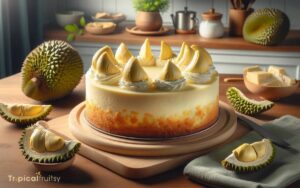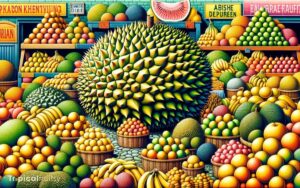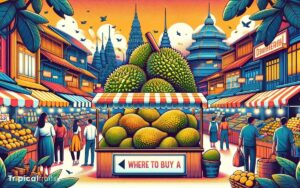How to Identify Musang King Durian? 9 Easy Steps!
To identify Musang King Durian, look for the following distinct characteristics: a bright yellow flesh, thick and creamy texture, and a strong, sweet aroma.
The outer shell usually has a greenish-yellow color and is covered with short, thick spikes. The fruit also has a unique star-shaped pattern on the bottom and its sections are easily distinguishable.
Musang King, also known as Durio zibethinus ‘Musang King’ or by its Malay name, “Raja Kunyit,” is one of the most sought-after durian varieties due to its rich flavor and creamy texture.
Here’s how to identify it:
Identifying a Musang King durian is a sensory experience, engulfing sight, touch, and smell with its unique features and unparalleled flavor profile.
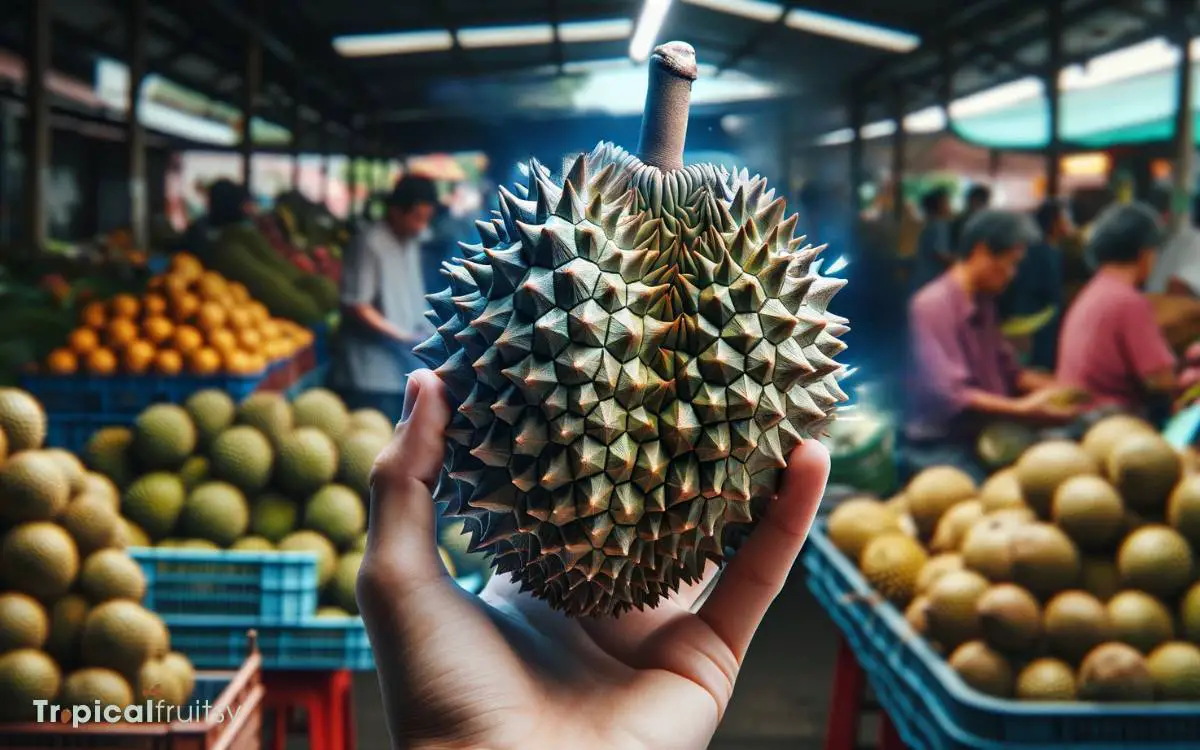
Key Takeaway
Step 1: Recognizing the Shape
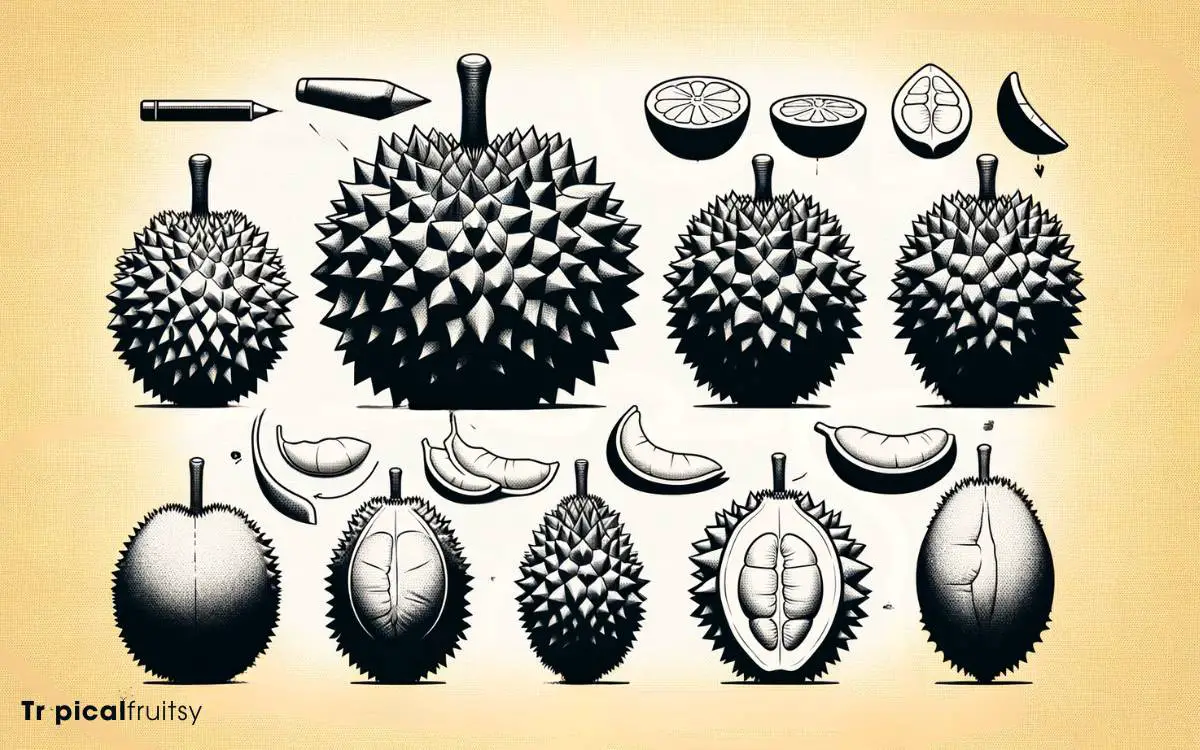
The Musang King durian is distinguished by its distinctively lobed and oblong shape, which sets it apart from other varieties. This particular characteristic provides a visual cue that facilitates its identification and selection.
Unlike the more rounded durians, the Musang King exhibits a pronounced curvature, with the lobes often appearing more defined and the stem more prominent.
Expert scrutiny reveals that the seams along the fruit, which demarcate the lobes, are deeper and more conspicuous, suggesting where the husk may split upon ripening.
This morphological feature is an essential indicator of the Musang King and is a primary factor that aficionados and cultivators alike utilize to authenticate the variety. The shape not only aids in recognition but also hints at the quality and lineage of the fruit.
Step 2: Examining the Husk Color
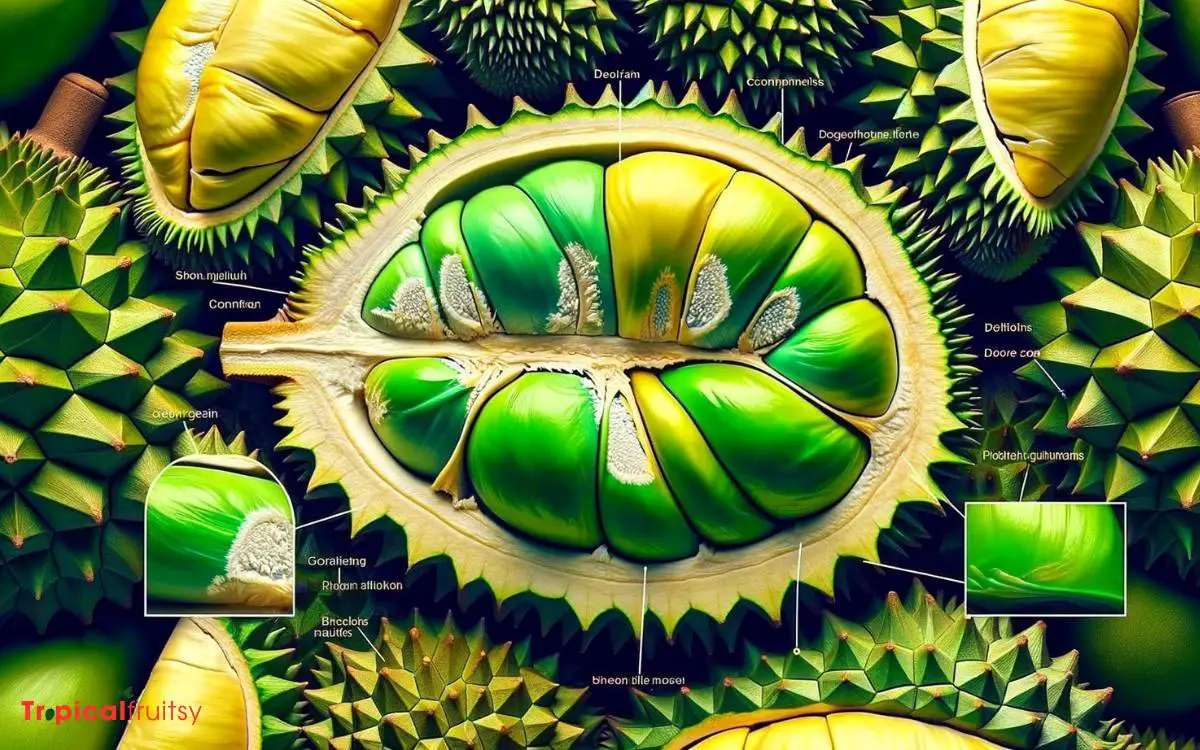
The husk color of a Musang King durian is a distinctive feature, typically exhibiting a greenish-brown hue that serves as an initial indicator of authenticity.
Observation of the husk should reveal a star-shaped pattern at the bottom of the fruit, a key characteristic unique to this variety.
It is important to note, however, that there can be slight variations in color uniformity due to environmental factors and ripeness levels.
Greenish Brown Hue
While evaluating a Musang King durian, one distinguishing feature is its unique greenish-brown hue that sets it apart from other durian varieties.
This specific coloration is a reliable indicator of the Musang King, also referred to as the ‘King of Durians.’
A discerning observer will note that the husk’s greenish tint is subtly overlaid with a brownish shade, which can vary from light to dark depending on the ripeness and origin of the fruit.
The intensity of the color can provide clues to the durian’s maturity and potential flavor profile. Careful inspection for this color blend can greatly enhance the accuracy of identification.
Star-Shaped Pattern Recognition
Recognition of the Musang King durian’s star-shaped pattern, a hallmark of its husk, is essential in the identification process and builds upon the initial assessment of its distinctive greenish-brown hue.
This pattern is not merely an aesthetic feature; it provides an additional layer of verification for connoisseurs and consumers alike.
To accurately discern this characteristic, one should:
- Examine the bottom of the fruit, where the pattern is most pronounced.
- Identify the five-pointed star shape, which is generally more defined in the Musang King variety.
- Observe the contrast between the star’s outline and the surrounding husk color.
- Ensure the star’s points are evenly spaced, signifying the fruit’s authenticity.
Through meticulous observation, the star-shaped pattern serves as a reliable indicator of the Musang King durian’s identity.
Color Uniformity Variations
Beyond the distinctive star-shaped pattern, the uniformity of the husk’s coloration is another crucial characteristic when identifying a Musang King durian.
The husk of the Musang King typically exhibits a consistent greenish-yellow hue, indicating ripeness and quality. Variations in this uniformity may suggest different stages of ripeness or quality differences.
| Aspect of Husk Color | Significance |
|---|---|
| Dark Green Patches | Underripe |
| Bright Yellow Tones | Peak Ripeness |
| Uniform Green-Yellow | High Quality |
| Brownish Spots | Overripe |
An analytical approach to examining the color involves assessing the prevalence and distribution of these hues. A Musang King durian with a uniformly rich, greenish-yellow tint across the husk suggests a premium selection.
As we proceed, understanding the nuances of this coloration can significantly aid in discerning the prized Musang King from other varieties.
Step 3: Noting the Stem Appearance
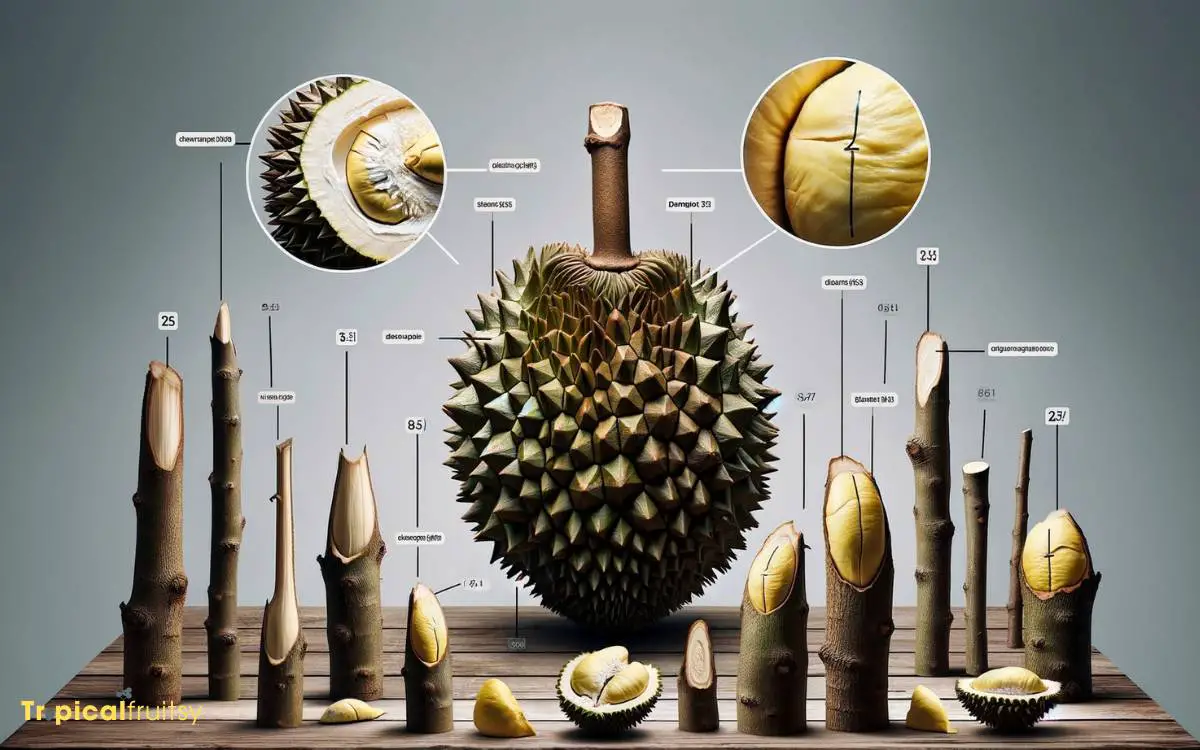
One distinguishing characteristic of the Musang King Durian is its stout, brown stem, which often exhibits a distinctive, thick appearance compared to other durian varieties.
When evaluating the stem of a Musang King Durian, consider the following attributes:
- Width: The stem is notably wider than those found on other durians, providing a robust anchor to the fruit.
- Coloration: It possesses a deep, tawny brown hue, a marker of its identity.
- Texture: Musang King stems have a rough, rigid surface that can be felt when handled.
- Shape: The stem is typically short and stubby, which can suggest a well-developed fruit.
These stem characteristics are integral to the overall assessment of the Musang King Durian, serving as a reliable parameter for aficionados seeking authenticity.
Step 4: Identifying the Thorn Structure
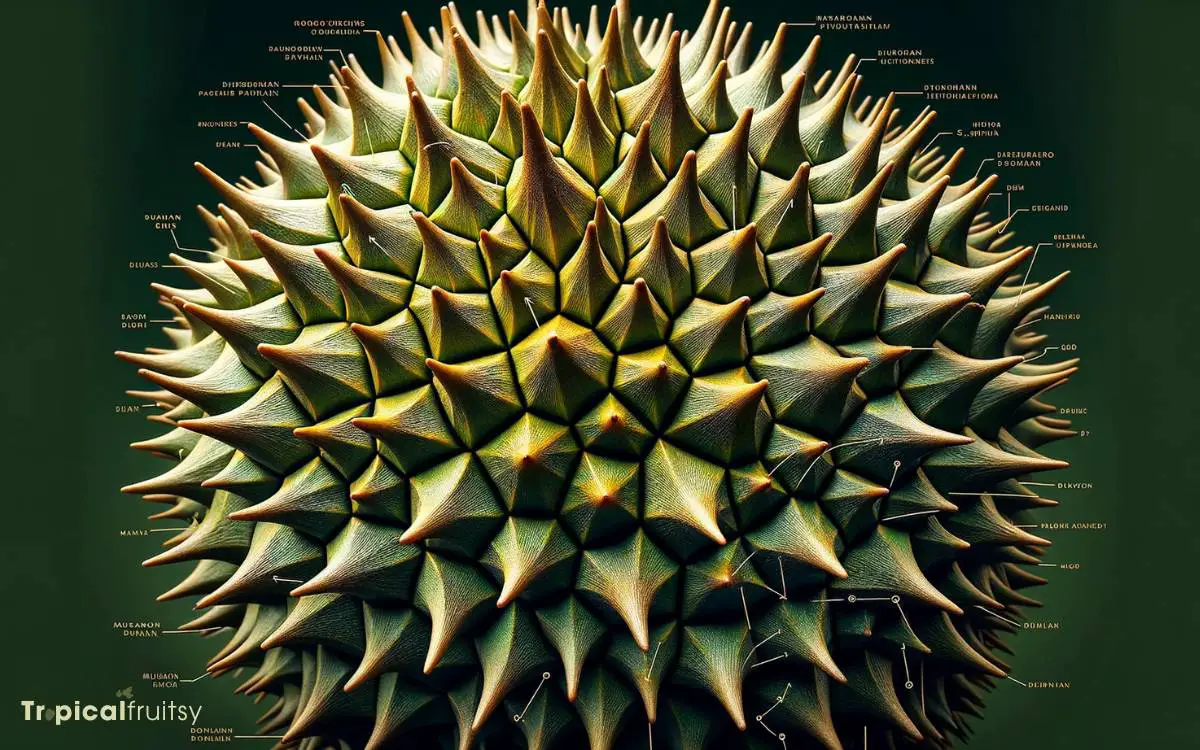
The thorn structure of a Musang King Durian is a defining characteristic that facilitates its identification.
Variations in thorn shape, including their curvature and density, can be critical indicators, distinguishing Musang King from other cultivars.
Recognizing these patterns requires a discerning eye, as subtle differences in thorn arrangement play a pivotal role in verification.
Thorn Shape Variation
Musang King durians are distinguished by their unique thorn structure, which features a pyramid shape with a relatively flat base compared to other varieties.
This distinct morphology is a key identifier, and discerning consumers can rely on the following characteristics:
- The thorns are typically stout and end in a blunted tip, creating a robust appearance.
- They are arrayed in a relatively uniform and orderly fashion, adhering to the fruit’s curved surface.
- Each thorn is separated by a shallow depression, giving the skin a less aggressive texture.
- The overall pattern formed by the thorns and depressions resembles a star-like motif when observed from the top view.
These structural nuances of the Musang King’s thorns contribute to its recognition and authentication.
Pattern Recognition Tips
To accurately identify Musang King durians, enthusiasts should focus on discerning the distinctive star-like pattern formed by the thorn structure.
This pattern is not merely a superficial feature but a botanical signature that distinguishes the Musang King from other varieties.
The thorns converge to create a five-pointed star when viewed at the base of the fruit. This pattern is consistent and serves as a reliable marker for identification.
Expertise in pattern recognition is critical; it requires a keen eye to observe the subtle yet definitive arrangement of thorns. The thorns on a Musang King are pyramid-shaped and densely packed, contributing to the overall star pattern.
Recognizing this unique structure is essential for durian connoisseurs and necessitates a methodical and analytical approach.
Step 5: Analyzing the Flesh Texture
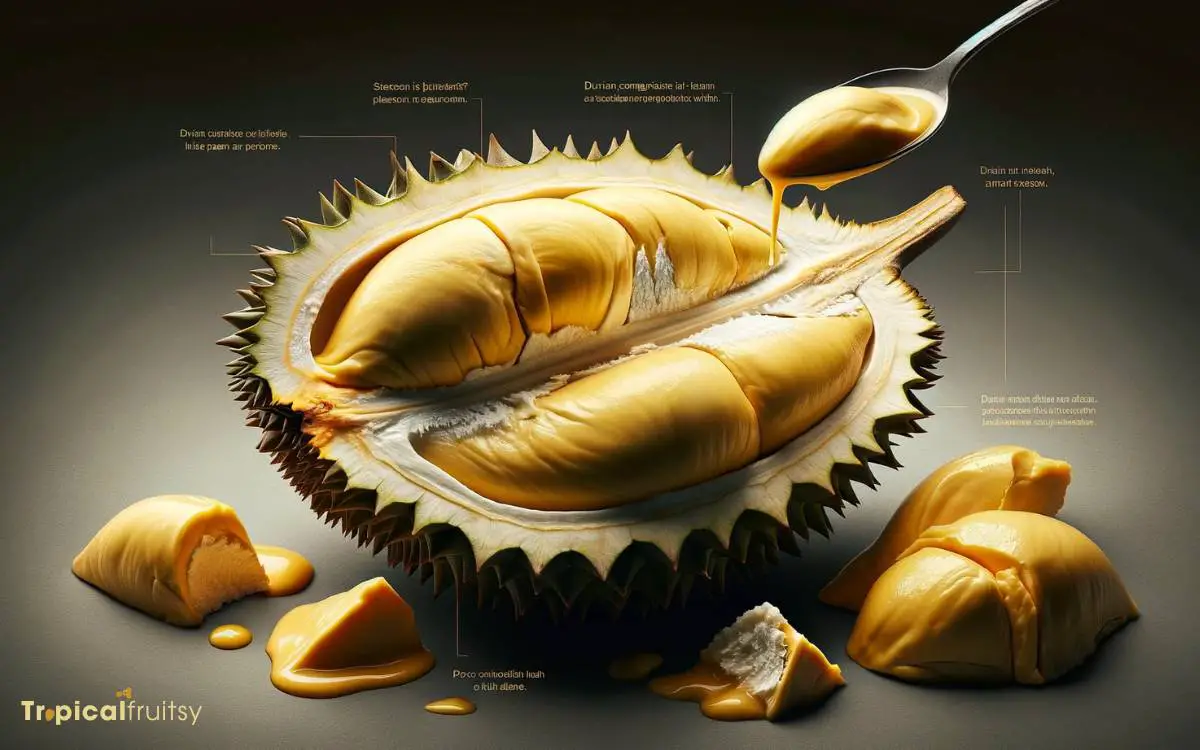
Durian aficionados recognize the Musang King variety by its distinctively creamy flesh, which sets it apart from other durian cultivars.
The flesh’s texture is a critical quality parameter and can be meticulously assessed by examining the following characteristics:
- Consistency: Musang King flesh is decadently thick, avoiding the fibrousness that can be present in other varieties.
- Smoothness: The flesh should be velvety smooth, with a buttery mouthfeel that is both luxurious and enveloping.
- Elasticity: A gentle yield under pressure is indicative of perfect ripeness, with the flesh bouncing back slightly to the touch.
- Moisture Content: While moist, the Musang King’s flesh is never watery; it maintains a custard-like richness that is dense yet not overly heavy.
Step 6: Discerning the Aroma Profile
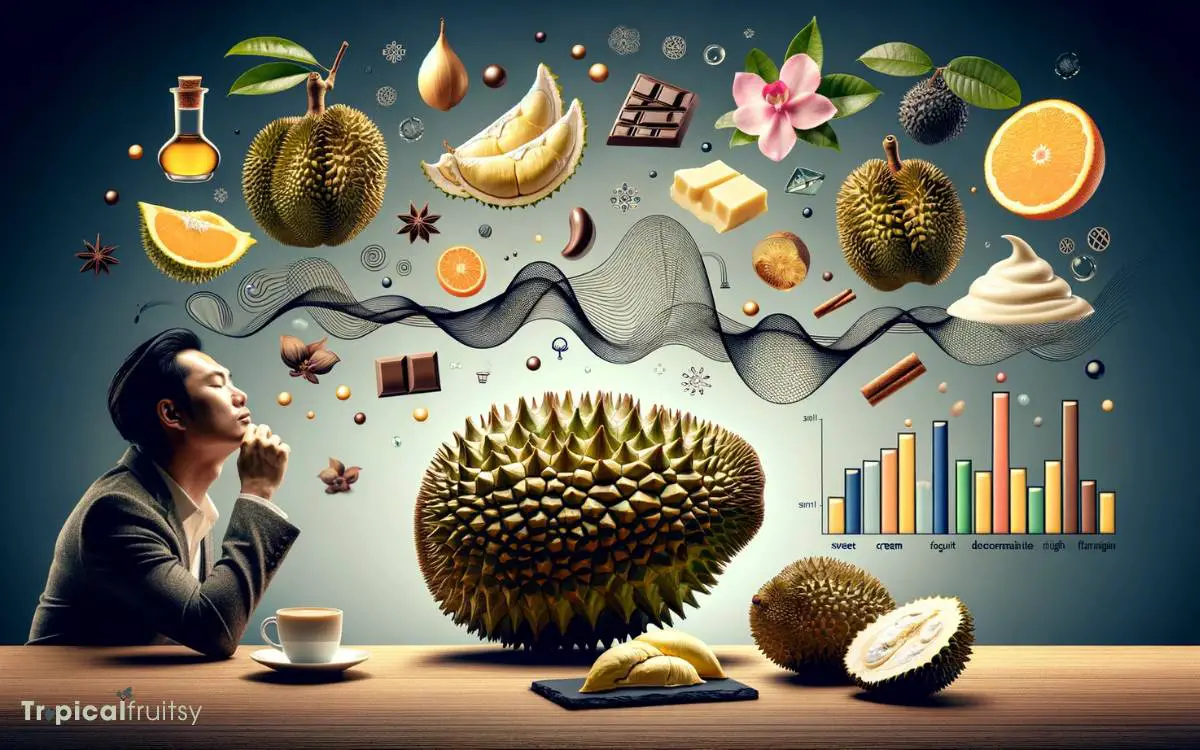
The distinctive scent of a Musang King durian is a powerful identifier, characterized by its rich and complex aroma that aficionados highly prize.
This premium variety exudes a bouquet that strikes a balance between sweet and savory notes, often described as having hints of roasted almond, caramelized onion, or even cheese.
The pungency is potent, yet it possesses a layered sweetness that lingers, distinguishing it from other durian varieties. Experts can discern the Musang King’s signature fragrance, which is both intense and pleasantly sweet, from afar.
Analyzing the aroma requires a discerning nose, familiar with the subtleties of durian scents and the ability to recognize the Musang King’s unique olfactory signature.
Step 7: Spotting the Seed Size
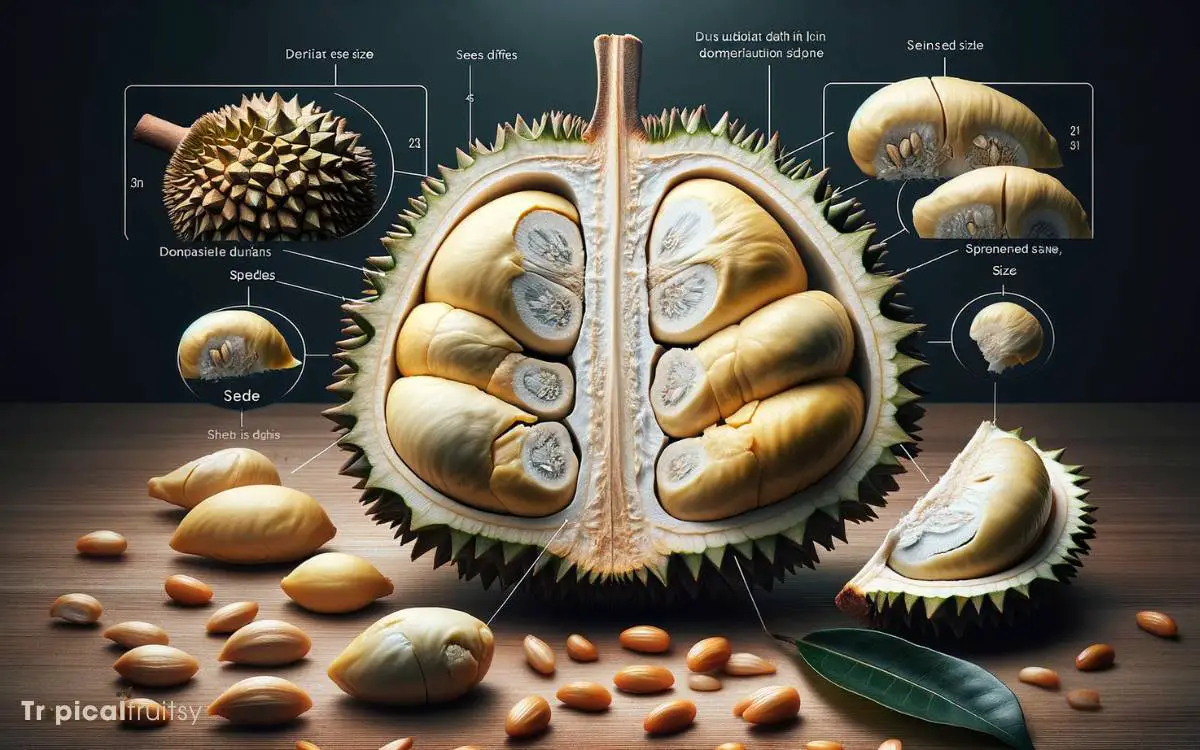
Evaluating the seed size can greatly aid in distinguishing the Musang King durian, as it typically features smaller and more flattened seeds compared to other varieties.
Discerning this characteristic involves a meticulous observation:
- The seeds are comparatively diminutive, often not exceeding the size of a small almond.
- Their shape tends to be ovate, with a discernible flattening that is less common in other durian types.
- The ratio of flesh to seed is higher, providing a more generous amount of edible portion.
- A gentle squeeze of the flesh can reveal the outline of the underlying seed, which should be subtle and less bulbous.
Step 8: Understanding the Taste Nuances
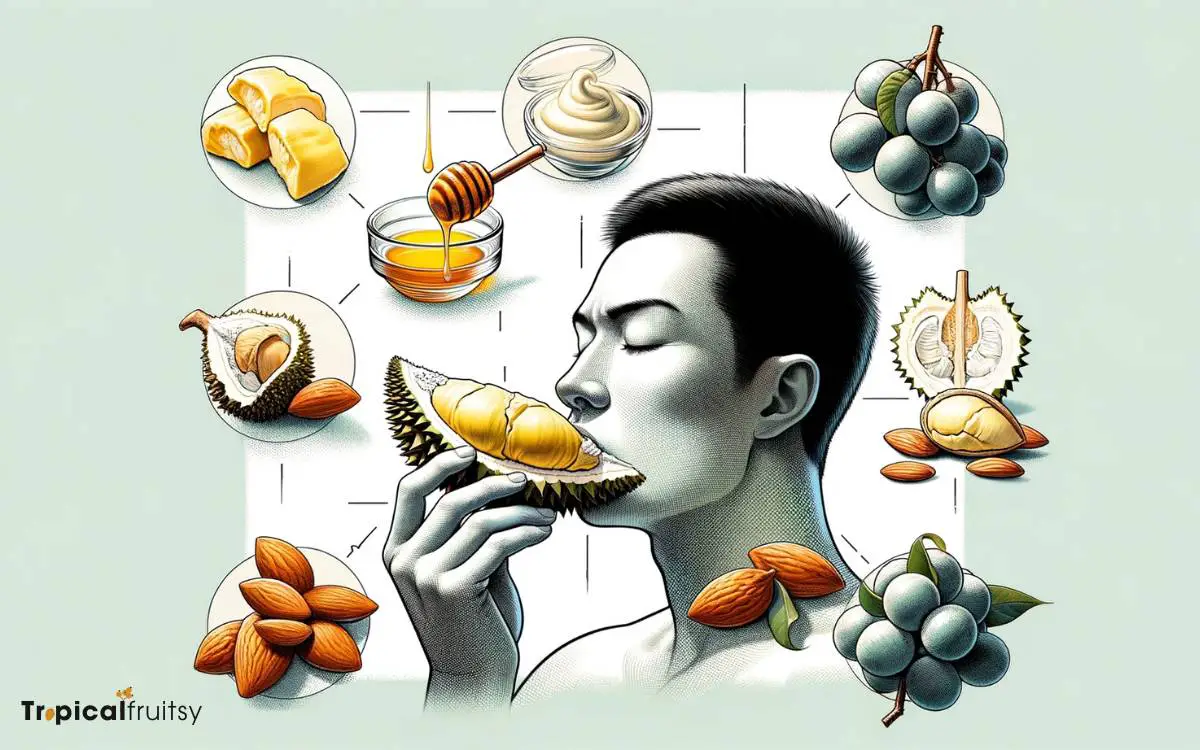
Musang King durian’s flavor profile distinguishes itself with a complex blend of creamy sweetness and subtle bitter undertones, a hallmark of this esteemed cultivar.
The sensory experience begins with a rich, custard-like texture that delivers a wave of intense sweetness, often described as a caramel or honey-like essence.
This initial taste is then intricately laced with a nuanced bitterness that provides a sophisticated counterpoint, enhancing the fruit’s depth of flavor. Connoisseurs appreciate this balance, as it reflects the durian’s ripeness and quality.
The Musang King’s lingering aftertaste, with notes of almond and a hint of fermented wine, further differentiates it from less nuanced varieties.
This multifaceted taste profile is a result of careful cultivation and expert selection, cementing its status as a premier choice among durian aficionados.
Step 9: Verifying Authenticity Tips
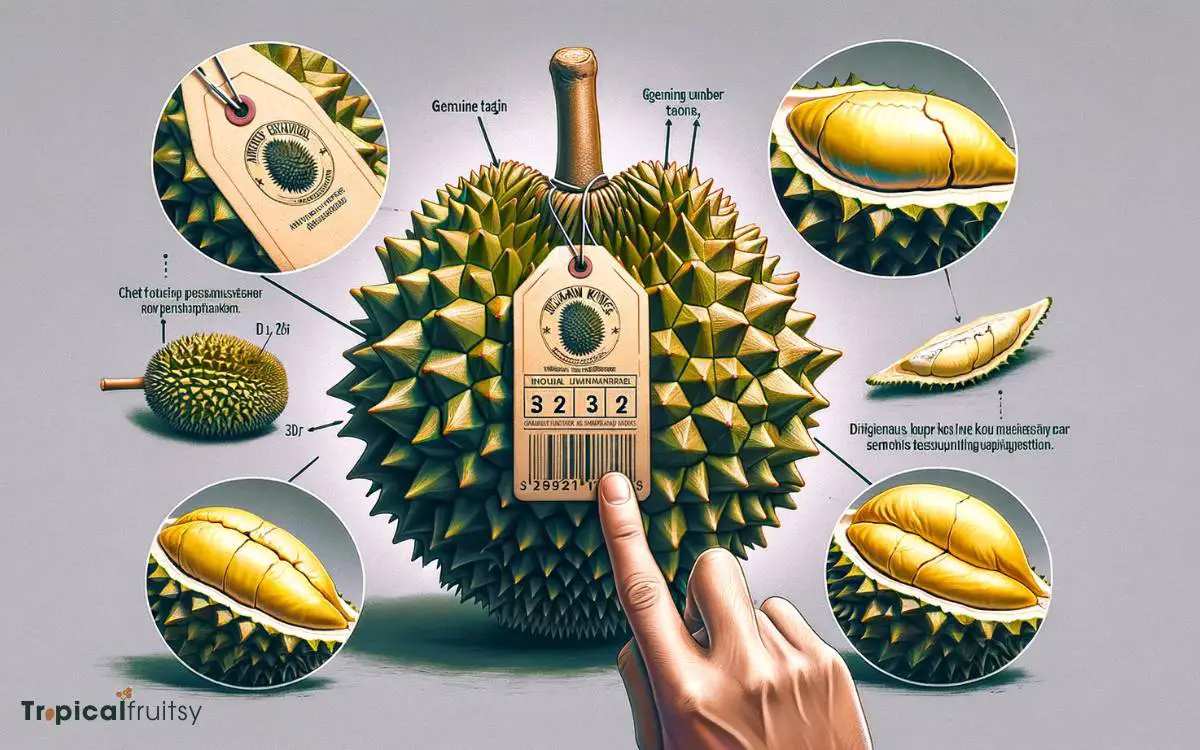
To ensure consumers are purchasing genuine Musang King durians, it is crucial to recognize specific physical characteristics that differentiate this premium variety from others.
Here are key features to look for:
- Shape: Authentic Musang King durians exhibit a distinctive shape, often appearing more oblong than round, and typically possess a noticeable bulge on one side.
- Color: The fruit’s husk should display a vibrant green hue with brownish-coppery speckles dispersed uniformly across its surface.
- Stem: A thick, stout stem is a hallmark of the Musang King, indicating its potential to support the weight of a mature fruit.
- Star-Cut Pattern: On the bottom of the durian, a star-shaped pattern is prominent, which is an indicator of the Musang King variety.
These elements, when analyzed collectively, form a framework for discerning the authenticity of a Musang King durian.
Conclusion
The Musang King durian commands connoisseur consideration. It is distinguished by its distinctive durian dialect of delightful nuances.
The star-shaped base, vibrant golden hue, sturdy stem, pyramid-like thorns, creamy custard-like flesh, pungent yet pleasing aroma, small seeds, and complex flavor profile are critical characteristics corroborated by careful scrutiny.
Connoisseurs can confirm the cultivar’s authenticity through these meticulous measures, safeguarding the sensory experience associated with this sovereign of succulence.



